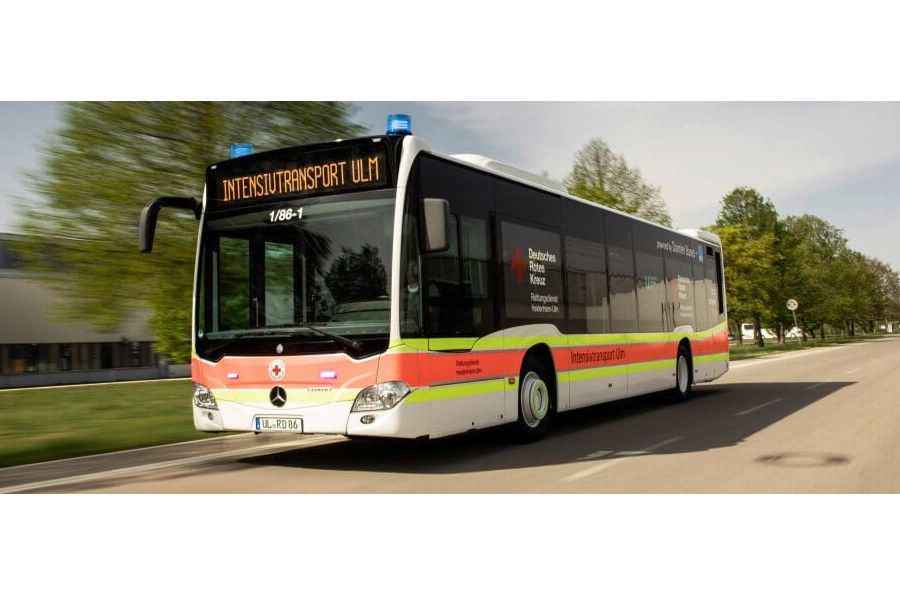Daimler Buses converts Mercedes-Benz Citaro for transporting COVID-19 patients

In only three weeks, Daimler Buses converted an inter-city bus into a special vehicle for the transfer of COVID-19 patients at its plant in Neu-Ulm. The Mercedes-Benz Citaro, now the largest intensive care ambulance in Germany, is to be used by DRK-Rettungsdienst Heidenheim-Ulm gGmbH (German Red Cross Emergency Medical Services Heidenheim-Ulm). The vehicle is a loan; initially it will be available to the German Red Cross (DRK) for a period of six months. The joint project is supported by the University Hospital in Ulm which is providing the specialized medical staff. SWU Stadtwerke Ulm/Neu-Ulm GmbH (public utility company) is also on board the project and is providing drivers and maintenance personnel.
"Among other professions, it is currently the staff in hospitals and care facilities who are working steadfastly and who particularly deserve our respect. Therefore, I am delighted that we are able to support the DRK by supplying transportation capacity. As a bus manufacturer, we want to contribute to the fight against the COVID-19 pandemic at a local level. A diverse range of activities at the Neu-Ulm plant show that there are good initiatives and strategies from our colleagues even now," Till Oberwörder, Head of Daimler Buses explains.
From the idea to implementation
David Richter, Managing Director of DRK-Rettungsdienst Heidenheim-Ulm had the idea of converting a bus in response to the need to increase intensive care transportation capacities, now necessary in many places. Daimler Buses was able to pledge its fast and uncomplicated support. Only a few days later a demonstration vehicle on stock at Daimler Buses was presented for conversion. A team of 12 employees from bus production in Neu-Ulm converted the bus to a high-capacity critical care ambulance in just 15 working days. Both the conversion and the supply of the medical equipment were completed in close co-operation with DRK-Rettungsdienst Heidenheim-Ulm.
"The high-capacity critical care ambulance puts DRK-Rettungsdienst Heidenheim-Ulm and the doctors from Ulm's University Hospital in a position to efficiently relieve hospitals where intensive care beds are in short supply. And not only in the Ulm/Neu-Ulm area but in other regions and states," says David Richter, Managing Director of DRK-Rettungsdienst Heidenheim-Ulm.
Professor Kühlmuß, District Medical Officer for DRK-Rettungsdienst adds: "Something that normally would take months and years was implemented within a few weeks together with Daimler Buses in an exemplary fashion. And in doing so, this is not just a bus, but an efficient transportation and relief concept. In my opinion this is only possible with such a transportation capacity."
High-capacity critical care ambulance helps with the transportation of intensive care patients
The Mercedes-Benz Citaro built in 2019 as an inter-city bus with 45 seats and standing room for 40 persons is equipped with four complete intensive care beds for its new function. Thanks to the repurposed bus, the German Red Cross in Ulm can react fast and transport intensive care patients to other hospitals if necessary. The journeys are supervised by two intensive-care doctors from the University Hospital in Ulm. Three paramedics and two ambulance officers supplied by DRK-Rettungsdienst Heidenheim-Ulm are also on board.
Professional medical equipment in the high-capacity critical care ambulance
The bus is equipped with four electrohydraulic wheeled stretchers with a loading system, four intensive care ventilators, four monitoring screens, a sonography unit and a blood gas analysis device, for example. The staff from Daimler Buses also created stowage space for sufficient medicines, nursing equipment, additional breathing apparatus and protective clothing. The Mercedes-Benz Citaro has been repurposed so that the patients can be transported in various positions. The side windows of the DRK bus have been laminated for privacy. The bus has also been equipped with a blue light and a siren.
Hygienically protected cockpit
As the bus will focus on transporting COVID-19 patients, hygienic demands played an important role during the conversion. For example, a disinfectant sprayer can be used in the patient compartment once transportation is completed. The area for the driver is separated from the patient compartment by a wall and the ventilation system has been converted. As a result the driver has no contact with patients and is not exposed to any infection. SWU Stadtwerke Ulm/Neu-Ulm is supporting the project by supplying drivers and a depot as well as taking care of technical maintenance.
Gunter Czisch, Mayor of the city of Ulm is full of praise for the initiative: "Represented by Stadtwerke Ulm/Neu-Ulm, we can be proud that we are a part of this unique pilot project. The transportation vehicle from the Daimler Buses plant in Neu-Ulm clearly shows what innovations the Ulm/Neu-Ulm region is capable of."
Managing Director of SWU Stadtwerke Ulm/Neu-Ulm GmbH, Klaus Eder, adds: "For some time now SWU has been supporting numerous initiatives and aid projects in the region under the motto #WirFürEuch (WeForYou). For us, organizing the driving staff for the transportation of critical care patients and taking care of the repairs and maintenance on the vehicle is a good opportunity to help. After all we transport over 40 million passengers safely and reliably every year."
Source of information
Daimler and ProfiBusiness.world
Date
April 29, 2020
Translator
News and information
Agriculture
Animals and pet supplies
Automotive
Banking and insurance
Boats and shipping industry
Building and architecture
Business
Education
Electrical industry
Electronics
Engineering
Environment
Finance, taxes and accounting
Flowers and plants
Food and beverage industry
For companies
Forestry and wood processing
Furniture
Gastronomy and hotel industry
Glass, ceramics and porcelain
Healthcare and pharmacy
Hobby and garden
Home and household goods
HR
Hygiene, drugstore and cosmetics
Charity and social responsibility
Chemical
Institution
IT and computers
Law and legislation
Management and certification systems
Minerals
Office
Packaging and packaging technologies
Paper industry
Plastic and rubber industry
Power engineering
PR and marketing
Printing and printing technology
Railway industry
Real estate
Safety, security and protection
Science and research
Social services
Sport and relax
Steel and iron processing
Telecommunications and the internet
Textile and leather industry
Tourism
Toys, games and entertainment
Transport and logistics


